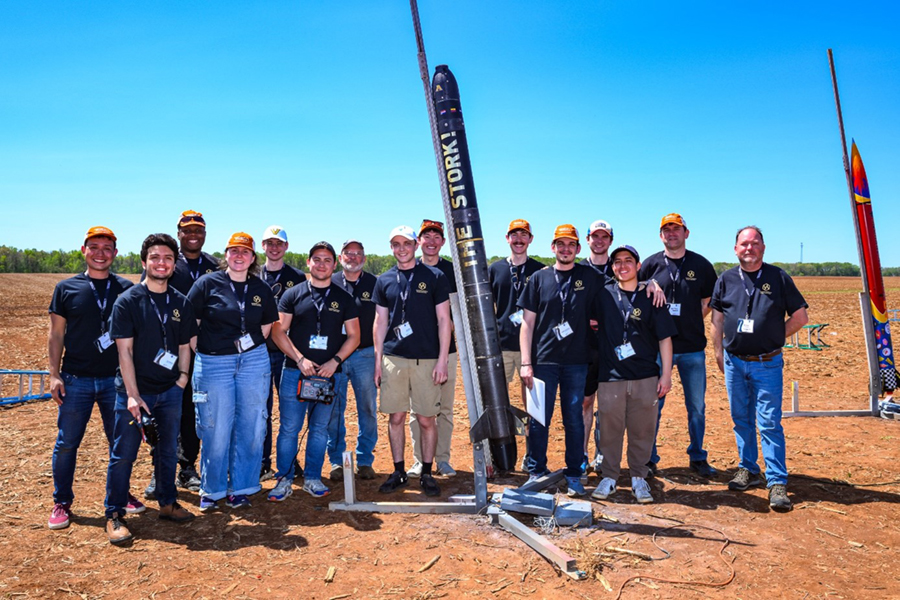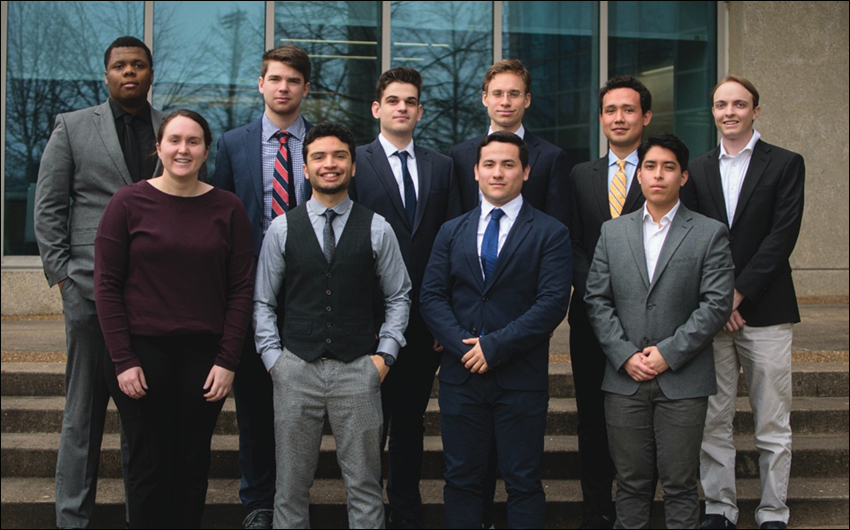
Rocket team members are staying in the lab this summer to work on two designs of the drone that netted the team a second place award in the coveted AIAA Reusable Launch Vehicle Innovative Payload category at the 2024 NASA University Student Launch Initiative (USLI) Division rocket competition in April. USLI results were announced June 10.
NASA implements a new payload challenge each year to reflect relevant missions. This year’s payload challenge is inspired by the Artemis missions that seek to land the first woman and first person of color on the Moon. In addition to the engineering and science side of the annual competition, students must also participate in outreach efforts such as engaging with local schools and maintaining effective social media accounts.
Teams designed a SAIL (STEMnaut Atmosphere Independent Lander) payload that must deploy mid-air, safely return to the ground without using a parachute, and be reusable to launch the same day without repairs or modifications. The payload also contained a crew of four STEMnauts, non-living objects representing astronauts. NASA personnel conducted extensive reviews to ensure the safety and feasibility of their rocket and payload designs.

“This was a challenging payload project, to detach a 5-pound or heavier lander without pyrotechnics and land it upright without a parachute,” said Professor A.V. Anilkumar, director of the Vanderbilt Aerospace Design Laboratory and the Mark Dalton Faculty Director of Experiential Learning in Aerospace Engineering. “Very few teams, along with Vanderbilt, qualified for the payload detachment finale as NASA deemed most projects unsafe for the final flight. At competition, the Vanderbilt team accomplished most of the goals and provided NASA with a comprehensive report.”
In the 2024 USLI competition, the Vanderbilt SAIL payload’s custom hinges that stow propellers in the rocket body unfolded properly once it cleared the body tube. The lander acted as the nose cone of the rocket, and a leveling system of gimbal rings kept the vehicle vertical during descent.
With Range Safety Officer approval, the lander successfully separated at 397 feet, within three feet of the competition detachment altitude. The STEMnauts ingress/egress door pointed upward upon tipping and coming to rest at landing. “The performance substantiates the efficacy of the SAIL system’s design in achieving controlled descent and a successful landing orientation,” said project leader Evangelos Chatziandreou.
Vanderbilt placed sixth in the overall competition that included 50 university teams. First place winner was the University of Notre Dame. The annual competition–one of NASA’s nine Artemis Student Challenges–requires students to design, build, and fly a high-powered amateur rocket and scientific payload. The 2024 nine-month-long challenge culminated with on-site events in April, with final launches April 13 at Bragg Farms in Toney, Alabama, just minutes north of NASA’s Marshall Space Flight Center in Huntsville, Alabama.

“Despite our payload performing very well it was the only category in which we were successful at the competition. We were a little disappointed that we stood sixth in the final tally,” said Jonathan Zak, the team’s lead vehicle engineer. “In the final analysis, we came up a bit short in some other key categories like rocket altitude and one of the reports that cost us dearly.” Vanderbilt rocket teams have won seven NASA national championships and eight payload design awards over the last 17 years.
Zak and Leonardo Brenes, payload lead, are in Nashville this summer to take the drone project further. They, and some other team members, are working on designs that include a lighter passive lander with no motorized controls and another motorized active lander with an innovative central thruster design that could potentially haul heavier loads at takeoff. “Our efforts are moving smoothly, and we expect to see the results by the end of summer,” Zak said.

“Thanks to the contributions from Mark Dalton, JD’75, former chair of the Vanderbilt Board of Trust and Vanderbilt Law School alumnus, to bolster innovative hands-on learning in aerospace design, we are able to retain students, pursue advanced research and development, and invite practicing alumni and distinguished aerospace professionals to VADL,” said Anilkumar.
Last year, VADL began a research collaboration with NASA Armstrong Flight Research Center to develop technologies for structural health monitoring of launch vehicles. This spring, graduate students Thomas Colicci and Andrew Noonan won the L. Michael Freeman Best Masters Paper award at the 2024 AIAA Region II Graduate Student Research Conference and have been selected to present their work on structural health monitoring for launch vehicle reusability at the AIAA International Student Conference.
